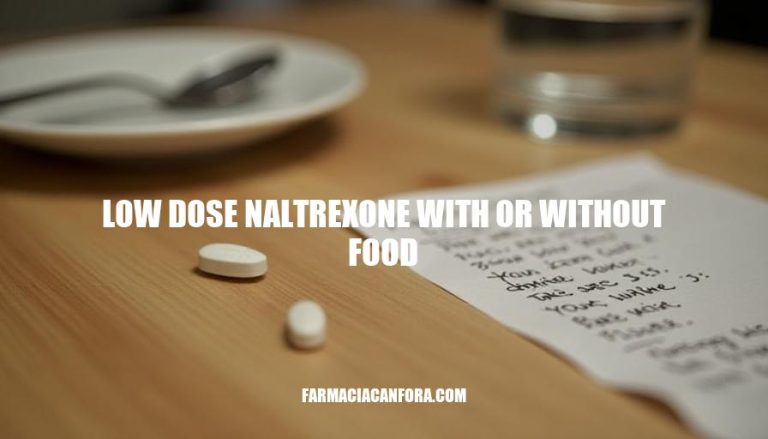


Low Dose Naltrexone (LDN) is a special version of a medicine called naltrexone. It’s used to help people with opioid addiction, but it also has other benefits. When taken in small doses, LDN can help with chronic pain and autoimmune diseases.
We’re going to talk about how to take LDN – whether it works better when you eat or not. This matters because it affects how the medicine is absorbed by your body.
Low-dose naltrexone (LDN) is an opioid receptor antagonist used off-label for various conditions, including chronic pain and inflammation. The absorption and efficacy of LDN can be influenced by food intake, and understanding these effects is crucial for optimizing its therapeutic benefits.
Scientific evidence suggests that food intake can significantly impact the pharmacokinetics of naltrexone. A study on adolescents with eating disorders found that food intake led to a large effect on the area under the concentration-time curve (AUC) for naltrexone, indicating increased systemic exposure.
However, the effect on the maximum concentration (Cmax) was highly variable and did not reach statistical significance. This variability suggests that while food can enhance overall exposure to naltrexone, the peak concentration achieved may not be consistently affected.
Expert opinions highlight the importance of considering food intake when administering LDN. Brenda Peralta, a registered dietitian, emphasizes that certain foods, particularly those high in fat, can increase the risk of liver disease, a potential side effect of naltrexone.
Therefore, it is advisable to avoid high-fat foods when taking LDN to minimize this risk.
Clinical studies have explored the effects of naltrexone on food intake and pleasantness. A double-blind placebo-controlled study found that naltrexone reduced the pleasantness of certain foods, particularly sweetened, fatty, and high-protein foods. This reduction in food pleasantness could potentially influence dietary habits and overall food intake, which may indirectly affect the absorption and efficacy of LDN.
Patient experiences with LDN also provide valuable insights.
Some patients report that taking LDN with food helps reduce gastrointestinal side effects such as nausea and stomach pain. However, others find that taking LDN on an empty stomach enhances its effectiveness, possibly due to faster absorption and higher peak concentrations.
In conclusion, the potential effects of food intake on the absorption and efficacy of low-dose naltrexone are multifaceted. While food can increase systemic exposure to naltrexone, the impact on peak concentration is variable.
High-fat foods should be avoided to reduce the risk of liver disease, and individual patient experiences may vary in terms of gastrointestinal side effects and overall effectiveness. Further research is needed to fully understand these interactions and optimize LDN therapy for different patient populations.
Low-dose naltrexone (LDN) is a medication that can have various benefits, including reducing chronic pain and autoimmune diseases. However, its absorption and efficacy can be influenced by food intake, making it essential to understand these interactions for optimal therapeutic benefits.
Research suggests that food can increase systemic exposure to LDN, but the impact on peak concentration is variable. A study found that food intake led to increased exposure to naltrexone, while another study showed that high-fat foods may increase the risk of liver disease, a potential side effect of naltrexone.
Patient experiences also provide valuable insights, with some reporting reduced gastrointestinal side effects when taking LDN with food, while others find that taking it on an empty stomach enhances its effectiveness. However, individual results may vary.
Ultimately, further research is needed to fully understand the interactions between food intake and LDN absorption. However, by considering these factors, patients and healthcare providers can work together to optimize LDN therapy and achieve better outcomes.